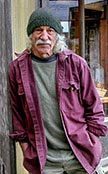A reconstruction of San Francisco around 1300 A.D. from Nob Hill, looking east across the bay toward Oakland. © Laura Cunningham
“California ecology used to be much more driven by floods and fires, Cunningham said, showing with her paintings how the Great Valley would become a vast inland sea, like a huge vernal pool progressing each year from navigable water to intense flower displays to elk-grazed grassland. Lake Merritt in Oakland was a salt water inlet. On the Albany mudflats grizzly bears would tunnel into a beached humpback whale for food, joined by California condors. Every fall at the Carquinez Strait a million four-foot-long chinook salmon headed inland to spawn.
Only 300 years ago the whole Bay Area was grasslands, routinely burned by the local Indians. There were oaks in the valleys, redwoods in the Berkeley Hills, and extensive oak savannahs inland. The hills were greener more of the year than now, with fire-freshened grass attracting elk, and native perennial grasses drawing moisture with their deep roots.
Cunningham researched the ancient landscapes using old maps, photos, paintings, scientific reports, sundry local experts, and 30 years of fieldwork. She witnessed the last wild condors feeding on a calf carcass, chasing off a golden eagle. (The condors are now back in the wild, spotted as far north as Mt. Hamilton.) To learn about the behavior and ecological effects of wolves and grizzly bears, she studied them in Yellowstone Park. (The California golden bear was enormous, up to 2,200 pounds.)
Along the Pacific shore there used to be 10-ton Stellar’s sea cows (extinct in 1768), a giant petrel with an 8-foot wingspan, and a flightless diving goose that ate mussels. Further back, in the Ice Ages before 12,000 years ago, the ocean was lower, and San Francisco Bay was a savannah occupied by huge bison (6 feet at the shoulder), a native fulll-sized horse similar to the African quagga (Cunningham shows it with quagga-like stripes), Columbian mammoths, and the giant short-faced bear (10 feet tall standing up).
For current Californians Cunningham encourages local restoration of old ecosystems, perhaps learning to live with more flood and fire. With her multi-millennial perspective, she’s pretty relaxed about climate change. As much as long-term ecology is about continuity, it is about change.
–Stewart Brand
[If you like these SALT talk summaries, all 100 or so of them are collected in Kindle format for $3, available here.]
—
Stewart Brand — sb@gbn.org
The Long Now Foundation – https://www.longnow.org
Seminars & downloads: https://www.longnow.org/seminars/”
https://www.heydaybooks.com/nature/a-state-of-change-forgotten-la.html




A lifetime ago I was just a hoosier yokel boy sitting in my eleventh grade ecology(!)class trying to stay awake when I noticed this…catalogue. There was a picture on the cover, a picture of this planet, taken from space.
My rather enlightened and sneakily irresponsible science teacher had left this…subversive material laying there where some innocent lad like myself might find it and thus learn to yearn for greater truth, a more better light-treading lifestyle and maybe something cool like a step van set up like a giant tool box. And I got all those things.
Thank you, Mr. Brand.
Tim Joe Comstock
I live right by Lake Merritt and it's still a salt water inlet, albeit hindered by gates and bridges. San Francisco is fascinating in that the western end of town was mostly barren sand dunes until the early 20th Century. The whole San Francisco Bay must have been something else to the first human eyes – now Emeryville has a "Shellmound Street" but no shellmound!
-Andy, Oakland